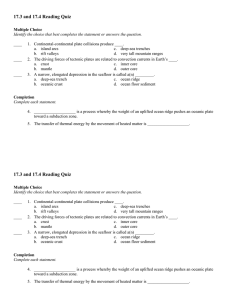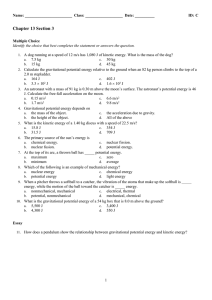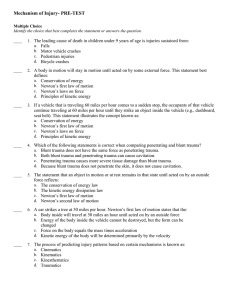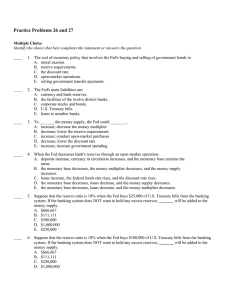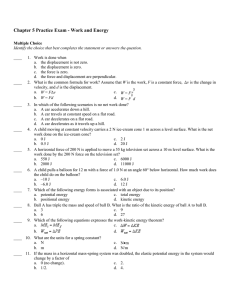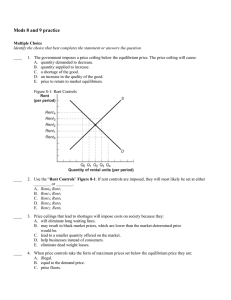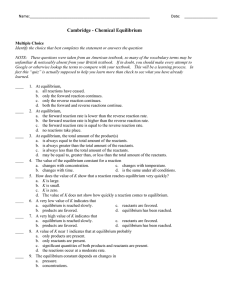S15 - cloudfront.net
Anuncio
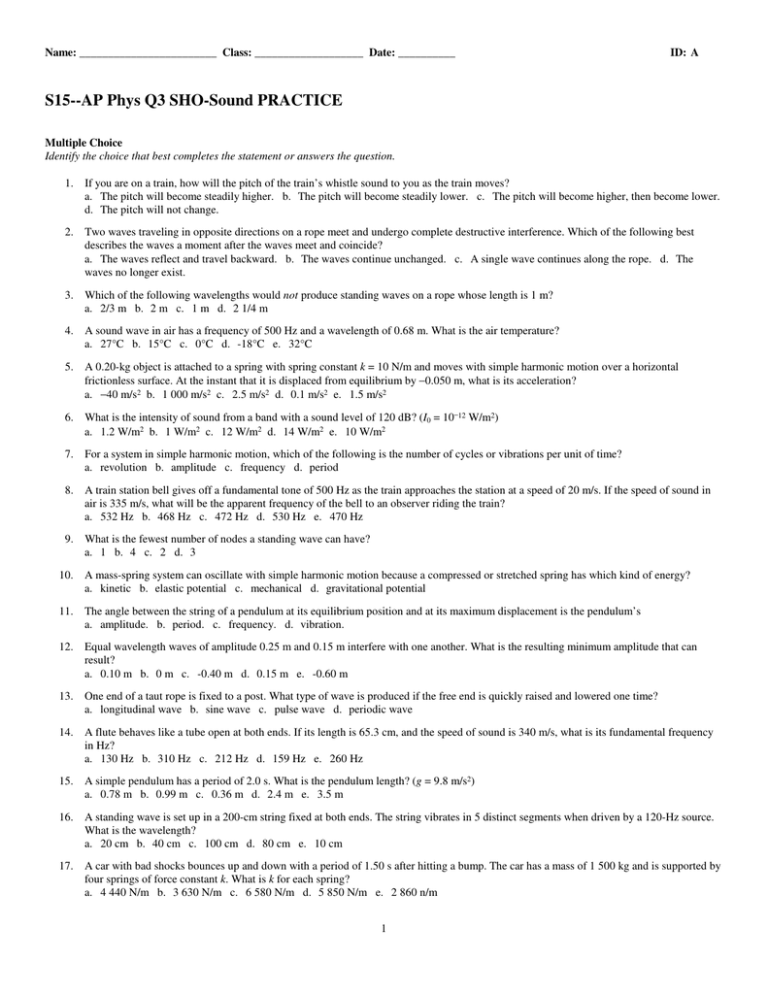
Name: ________________________ Class: ___________________ Date: __________ ID: A S15--AP Phys Q3 SHO-Sound PRACTICE Multiple Choice Identify the choice that best completes the statement or answers the question. 1. If you are on a train, how will the pitch of the train’s whistle sound to you as the train moves? a. The pitch will become steadily higher. b. The pitch will become steadily lower. c. The pitch will become higher, then become lower. d. The pitch will not change. 2. Two waves traveling in opposite directions on a rope meet and undergo complete destructive interference. Which of the following best describes the waves a moment after the waves meet and coincide? a. The waves reflect and travel backward. b. The waves continue unchanged. c. A single wave continues along the rope. d. The waves no longer exist. 3. Which of the following wavelengths would not produce standing waves on a rope whose length is 1 m? a. 2/3 m b. 2 m c. 1 m d. 2 1/4 m 4. A sound wave in air has a frequency of 500 Hz and a wavelength of 0.68 m. What is the air temperature? a. 27°C b. 15°C c. 0°C d. -18°C e. 32°C 5. A 0.20-kg object is attached to a spring with spring constant k = 10 N/m and moves with simple harmonic motion over a horizontal frictionless surface. At the instant that it is displaced from equilibrium by −0.050 m, what is its acceleration? a. −40 m/s2 b. 1 000 m/s2 c. 2.5 m/s2 d. 0.1 m/s2 e. 1.5 m/s2 6. What is the intensity of sound from a band with a sound level of 120 dB? (I0 = 10−12 W/m2) a. 1.2 W/m2 b. 1 W/m2 c. 12 W/m2 d. 14 W/m2 e. 10 W/m2 7. For a system in simple harmonic motion, which of the following is the number of cycles or vibrations per unit of time? a. revolution b. amplitude c. frequency d. period 8. A train station bell gives off a fundamental tone of 500 Hz as the train approaches the station at a speed of 20 m/s. If the speed of sound in air is 335 m/s, what will be the apparent frequency of the bell to an observer riding the train? a. 532 Hz b. 468 Hz c. 472 Hz d. 530 Hz e. 470 Hz 9. What is the fewest number of nodes a standing wave can have? a. 1 b. 4 c. 2 d. 3 10. A mass-spring system can oscillate with simple harmonic motion because a compressed or stretched spring has which kind of energy? a. kinetic b. elastic potential c. mechanical d. gravitational potential 11. The angle between the string of a pendulum at its equilibrium position and at its maximum displacement is the pendulum’s a. amplitude. b. period. c. frequency. d. vibration. 12. Equal wavelength waves of amplitude 0.25 m and 0.15 m interfere with one another. What is the resulting minimum amplitude that can result? a. 0.10 m b. 0 m c. -0.40 m d. 0.15 m e. -0.60 m 13. One end of a taut rope is fixed to a post. What type of wave is produced if the free end is quickly raised and lowered one time? a. longitudinal wave b. sine wave c. pulse wave d. periodic wave 14. A flute behaves like a tube open at both ends. If its length is 65.3 cm, and the speed of sound is 340 m/s, what is its fundamental frequency in Hz? a. 130 Hz b. 310 Hz c. 212 Hz d. 159 Hz e. 260 Hz 15. A simple pendulum has a period of 2.0 s. What is the pendulum length? (g = 9.8 m/s2) a. 0.78 m b. 0.99 m c. 0.36 m d. 2.4 m e. 3.5 m 16. A standing wave is set up in a 200-cm string fixed at both ends. The string vibrates in 5 distinct segments when driven by a 120-Hz source. What is the wavelength? a. 20 cm b. 40 cm c. 100 cm d. 80 cm e. 10 cm 17. A car with bad shocks bounces up and down with a period of 1.50 s after hitting a bump. The car has a mass of 1 500 kg and is supported by four springs of force constant k. What is k for each spring? a. 4 440 N/m b. 3 630 N/m c. 6 580 N/m d. 5 850 N/m e. 2 860 n/m 1 Name: ________________________ ID: A 18. What is the phase difference when two waves, traveling in the same medium, undergo constructive interference? a. 0° b. 270° c. 180° d. 90° e. none of the above. 19. A C note (f = 256 Hz) is sounded on a piano. If the length of the piano wire is 1.00 m and its mass density is 2.50 g/m, what is the tension in the wire? a. 1 450 N b. 84 N c. 168 N d. 1 280 N e. 655 N 20. The wavelength of the fundamental frequency of a vibrating string of length L is a. L. b. 2L. c. 4L. d. 1/2 L. 21. Assuming that the wave speed varies little when sound waves are traveling though a material that suddenly changes density by 10%, what percentage of the incident wave intensity is reflected? a. < 1 % b. 30% c. 10 % d. 5 % e. 20 % 22. Consider a vibrating string that makes a sound wave that moves through the air. As the guitar string moves up and down, the air molecules that are a certain horizontal distance from the string will move: a. up and down. b. back and forth along the direction of the length of the string. c. in circles around the guitar string. d. toward and away from the guitar string. e. none of the above. 23. If I triple the mass per unit length of guitar string, its natural frequency changes by what factor? a. 1.7 b. 1.0 c. 9.0 d. 0.58 e. 3.0 24. Two cars, one in front of the other, are traveling down the highway at 25 m/s. The car behind sounds its horn, which has a frequency of 500 Hz. What is the frequency heard by the driver of the lead car? (vsound = 340 m/s) a. 463 Hz b. 540 Hz c. 500 Hz d. 580 Hz e. 579 Hz 25. Consider the curve f(x) = A cos(2πx/λ). The wavelength of the wave will be: a. the distance x2 to x3. b. the distance 0 to x1. c. twice the distance 0 to A. d. the distance 0 to A. e. twice the distance x2 to x3. 26. A 2.0 m long stretched rope is fixed at both ends. Which wavelength would not produce standing waves on this rope? a. 2.0 m b. 4.0 m c. 6.0 m d. 3.0 m 27. Consider two identical and symmetrical wave pulses on a string. Suppose the first pulse reaches the fixed end of the string and is reflected back and then meets the second pulse. When the two pulses overlap exactly, the superposition principle predicts that the amplitude of the resultant pulses, at that moment, will be what factor times the amplitude of one of the original pulses? a. 8 b. 0 c. 2 d. 4 e. 1 28. A standing wave is set up in a 2.0-m string fixed at both ends. The string vibrates in 5 distinct segments when driven by a 120-Hz source. In how many distinct standing wave segments will the string vibrate if the tension is increased by a factor of 4? a. 30 b. 20 c. 10 d. 3 e. No standing wave pattern occurs. 29. For a mass suspended on a spring in the vertical direction, the time for one complete oscillation will depend on: a. the value for g (the acceleration due to gravity). b. the distance the mass was originally pulled down. c. the maximum speed of the oscillating mass. d. the time doesn't depend on any of the above. e. both choices A and C are valid. 30. Two mechanical waves can occupy the same space at the same time because waves a. are displacements of matter. b. do not cause interference patterns. c. are matter. d. cannot pass through one another. 31. If a guitar string has a fundamental frequency of 500 Hz, what is the frequency of its second overtone? a. 1 000 Hz b. 250 Hz c. 1 700 Hz d. 1 500 Hz e. 750 Hz 2 Name: ________________________ ID: A 32. Which is not an example of approximate simple harmonic motion? a. A ball bouncing on the floor. b. A child swinging on a swing. c. A piano string that has been struck. d. A car's radio antenna as it waves back and forth. e. Both choices A and D are valid. 33. The superposition of mechanical waves can be observed in the movement of a. bumper cars. b. violin bows in an orchestra. c. electromagnetic radiation. d. water waves in a ripple tank. 34. Which of the following types of interference will occur when the pulses in the figure above meet? a. total interference b. destructive interference c. no interference d. constructive interference 35. How many beats per second are heard when two vibrating tuning forks having frequencies of 342 Hz and 345 Hz are held side by side? a. 343.5 Hz b. 5 Hz c. 3 Hz d. 687 Hz 36. The perceived loudness of a sound is measured in a. watts. b. decibels. c. hertz. d. watts per square meter. 37. Of the frequencies listed below, to which one is the human ear most sensitive? a. 3 300 Hz b. 33 Hz c. 330 Hz d. 33 000 Hz e. 330 000 Hz 38. If one-third of the members of a symphony orchestra are absent because of head colds, thus reducing the overall intensity of sound by 33%, what will be the reduction in the decibel level? a. 1.7 dB b. 17 dB c. 3 dB d. 48 dB e. 30 dB 39. Which of the following ranges corresponds to the longest wavelengths? a. infrasonic b. audible c. ultrasonic d. all have the same wavelengths e. both choices A and B are valid 40. How are frequency and period related in simple harmonic motion? a. Both measure the number of cycles per unit of time. b. They are directly related. c. Their sum is constant. d. They are inversely related. 41. A large spring requires a force of 150 N to compress it only 0.010 m. What is the spring constant of the spring? a. 15 000 N/m b. 1.5 N/m c. 125 000 N/m d. 15 N/m e. 1.0 N/m 42. An earthquake emits both P-waves and S-waves that travel at different speeds through the Earth. A P-wave travels at 8 000 m/s and an S-wave at 4 000 m/s. If P-waves are received at a seismic station 30.0 s before an S-wave arrives, how far is the station from the earthquake center? a. 240 km b. 1 210 km c. 120 km d. 100 km e. 2 420 km 43. Suppose that two sound waves passing through the same medium have different wavelengths. Which of the following is most likely to be the reason for the differing wavelengths? a. the nature of the medium b. differences in frequency c. differences in amplitude d. the type of wave 44. A musical tone, sounded on a piano, has a frequency of 410 Hz and a wavelength in air of 0.800 m. What is the wave speed? a. 235 m/s b. 587 m/s c. 170 m/s d. 673 m/s e. 328 m/s 45. How far away is a lightning strike if you hear the thunderclap 3.00 s after you see the lightning bolt strike? (vsound = 340 m/s, vlight = 3 × 108 m/s) a. 113 m b. 1 350 m c. 1 020 m d. 340 m e. 680 m 46. In general, sound travels faster through a. gases than through solids. b. empty space than through matter. c. solids than through gases. d. gases than through liquids. 3 Name: ________________________ ID: A 47. If a radio wave has speed 3.00 × 108 m/s and frequency 94.7 MHz, what is its wavelength? a. 8.78 m b. 3.17 m c. 2.50 m d. 1.20 m e. 4.21 m 48. The Doppler effect occurs with a. only transverse waves. b. only sound waves. c. only water waves. d. all waves. 49. By what factor must one change the weight suspended vertically from a spring coil in order to triple its period of simple harmonic motion? a. 12 b. 3.0 c. 9.0 d. 1/9 e. 0.33 50. The motion of a piston in an automobile engine is nearly simple harmonic. If the 1-kg piston travels back and forth over a total distance of 10.0 cm, what is its maximum speed when the engine is running at 3 000 rpm? a. 3.93 m/s b. 31.4 m/s c. 1.66 m/s d. 15.7 m/s e. 7.85 m/s 51. Which of the following is a single nonperiodic disturbance? a. transverse wave b. pulse wave c. sine wave d. periodic wave 52. For a system in simple harmonic motion, which of the following is the time required to complete a cycle of motion? a. amplitude b. frequency c. revolution d. period Problem 53. A musical tone sounded on a piano has a frequency of 261.6 Hz and a wavelength of 1.31 m. What is the speed of the sound wave? 54. Radio waves from an FM station have a frequency of 103.1 MHz. If the waves travel with a speed of 3.00 × 10 8 m/s, what is the wavelength? 55. A periodic wave has a wavelength of 0.50 m and a speed of 20 m/s. What is the wave frequency? 56. On the planet Xenos, an astronaut observes that a 1.00 m long pendulum has a period of 1.50 s. What is the free-fall acceleration on Xenos? 57. An amusement park ride has a frequency of 0.05 Hz. What is the ride’s period? 58. Imagine that you could transport a simple pendulum from Earth to the moon, where the free-fall acceleration is one-sixth that on Earth. By what factor would the pendulum’s frequency be changed? Express the answer with one significant figure. 59. A 0.20 kg mass suspended from a spring moves with simple harmonic motion. At the instant the mass is displaced from equilibrium by –0.050 m, what is its acceleration? (The spring constant is 10.0 N/m.) 60. If a force of 50 N stretches a spring 0.10 m, what is the spring constant? 4 ID: A S15--AP Phys Q3 SHO-Sound PRACTICE Answer Section MULTIPLE CHOICE 1. 2. 3. 4. 5. 6. 7. 8. 9. 10. 11. 12. 13. 14. 15. 16. 17. 18. 19. 20. 21. 22. 23. 24. 25. 26. 27. 28. 29. 30. 31. 32. 33. 34. 35. 36. 37. 38. 39. 40. 41. 42. ANS: ANS: ANS: ANS: ANS: ANS: ANS: ANS: ANS: ANS: ANS: ANS: TOP: ANS: ANS: ANS: ANS: ANS: TOP: ANS: ANS: ANS: ANS: ANS: ANS: ANS: ANS: TOP: ANS: ANS: TOP: ANS: ANS: TOP: ANS: ANS: ANS: ANS: ANS: ANS: ANS: ANS: ANS: ANS: ANS: ANS: ANS: TOP: D PTS: 1 DIF: II OBJ: 12-1.5 B PTS: 1 DIF: II OBJ: 11-4.1 D PTS: 1 DIF: I OBJ: 11-4.4 B PTS: 1 DIF: 2 TOP: 14.3 The Speed of Sound C PTS: 1 DIF: 2 TOP: 13.1 Hooke's Law B PTS: 1 DIF: 2 TOP: 14.4 Energy and Intensity of Sound Waves C PTS: 1 DIF: I OBJ: 11-2.2 D PTS: 1 DIF: 2 TOP: 14.6 The Doppler Effect C PTS: 1 DIF: I OBJ: 11-4.5 B PTS: 1 DIF: II OBJ: 11-1.2 A PTS: 1 DIF: I OBJ: 11-2.1 A PTS: 1 DIF: 2 13.10 Interference of Waves | 13.11 Reflection of Waves C PTS: 1 DIF: I OBJ: 11-3.2 E PTS: 1 DIF: 2 TOP: 14.10 Standing Waves in Air Columns B PTS: 1 DIF: 2 TOP: 13.5 Motion of a Pendulum D PTS: 1 DIF: 2 TOP: 14.8 Standing Waves C PTS: 1 DIF: 2 13.3 Comparing Simple Harmonic Motion with Uniform Circular Motion A PTS: 1 DIF: 1 TOP: 13.9 The Speed of Waves on Strings E PTS: 1 DIF: 2 TOP: 14.8 Standing Waves B PTS: 1 DIF: I OBJ: 12-3.2 A PTS: 1 DIF: 2 TOP: 14.2 Characteristics of Sound Waves D PTS: 1 DIF: 1 TOP: 14.1 Producing a Sound Wave D PTS: 1 DIF: 2 TOP: 14.8 Standing Waves C PTS: 1 DIF: 2 TOP: 14.6 The Doppler Effect E PTS: 1 DIF: 2 13.6 Damped Oscillations | 13.7 Waves | 13.8 Frequency | Amplitude | and Wavelength D PTS: 1 DIF: IIIA OBJ: 11-4.4 B PTS: 1 DIF: 2 13.10 Interference of Waves | 13.11 Reflection of Waves E PTS: 1 DIF: 3 TOP: 14.8 Standing Waves D PTS: 1 DIF: 1 13.3 Comparing Simple Harmonic Motion with Uniform Circular Motion A PTS: 1 DIF: I OBJ: 11-4.1 D PTS: 1 DIF: 2 TOP: 14.8 Standing Waves A PTS: 1 DIF: 1 TOP: 13.1 Hooke's Law D PTS: 1 DIF: I OBJ: 11-4.1 B PTS: 1 DIF: I OBJ: 11-4.2 C PTS: 1 DIF: IIIA OBJ: 12-3.4 B PTS: 1 DIF: I OBJ: 12-2.2 A PTS: 1 DIF: 1 TOP: 14.13 The Ear A PTS: 1 DIF: 2 TOP: 14.4 Energy and Intensity of Sound Waves A PTS: 1 DIF: 1 TOP: 14.2 Characteristics of Sound Waves D PTS: 1 DIF: I OBJ: 11-2.2 A PTS: 1 DIF: 1 TOP: 13.1 Hooke's Law A PTS: 1 DIF: 2 13.6 Damped Oscillations | 13.7 Waves | 13.8 Frequency | Amplitude | and Wavelength 1 ID: A 43. 44. 45. 46. 47. 48. 49. 50. 51. 52. ANS: ANS: TOP: ANS: ANS: ANS: TOP: ANS: ANS: TOP: ANS: TOP: ANS: ANS: B PTS: 1 DIF: II OBJ: 11-3.4 E PTS: 1 DIF: 1 13.6 Damped Oscillations | 13.7 Waves | 13.8 Frequency | Amplitude | and Wavelength C PTS: 1 DIF: 2 TOP: 14.3 The Speed of Sound C PTS: 1 DIF: I OBJ: 12-1.3 B PTS: 1 DIF: 1 13.6 Damped Oscillations | 13.7 Waves | 13.8 Frequency | Amplitude | and Wavelength D PTS: 1 DIF: I OBJ: 12-1.5 C PTS: 1 DIF: 2 13.3 Comparing Simple Harmonic Motion with Uniform Circular Motion D PTS: 1 DIF: 3 13.4 Position | Velocity | and Acceleration as a Function of Time B PTS: 1 DIF: I OBJ: 11-3.2 D PTS: 1 DIF: I OBJ: 11-2.2 PROBLEM 53. ANS: 343 m/s Given f = 261.6 Hz λ = 1.31 m Solution v = fλ v = (261.6 Hz)(1.31 m) = 343 m/s 54. PTS: 1 ANS: 2.91 m DIF: IIIA OBJ: 11-3.4 Given f = 103.1 MHz v = 3.00 × 10 8 m/s f = 103.1 MHz = 1.031 × 10 8 Hz Solution v = fλ λ = v/f = (3.00 × 10 8 m/s)/(1.031 × 10 8 Hz) = 2.91 m 55. PTS: ANS: 40 Hz 1 DIF: IIIA OBJ: 11-3.4 DIF: IIIA OBJ: 11-3.4 Given v = 20 m/s λ = 0.50 m Solution v = fλ v 20 m/s f= = = 40 Hz λ 0.50 m PTS: 1 2 ID: A 56. ANS: 17.6 m/s 2 Given L = 1.00 m T = 1.50 s Solution ÊÁ ÁÁ L L , so T 2 = 4π 2 ÁÁÁÁ ag ÁÁ a g Ë T = 2π ag = 57. 4π 2 L T PTS: ANS: 20 s 2 ÊÁ 2 Á 1.00 m = 4π ÁÁÁÁ ÁÁ (1.50 s) 2 Ë 1 ˆ˜ ˜˜˜ ˜˜ ˜˜˜ ¯ ˆ˜ ˜˜˜ 2 ˜˜ = 17.6 m/s ˜˜ ¯ DIF: IIIB OBJ: 11-2.3 DIF: IIIA OBJ: 11-2.3 Given f = 0.05 Hz Solution 1 1 T= = f 0.05 Hz T = 20s PTS: 1 3 ID: A 58. ANS: 0.4 Given ag = 1 g 6 Solution L ag T = 2π Because L and 2π remain constant when the pendulum is 1 , where a g is the gravitational ag moved to the moon, T moon ∝ acceleration of the moon. T moon T earth f= 59. 1 ag = = 1 g f moon 1 , so = T f earth PTS: ANS: 1 g ag ag g = 1 = 0.4 6 DIF: IIIB OBJ: 11-2.3 IIIA OBJ: 11-1.3 2.5 m/s 2 Given m = 0.20 kg k = 10.0 N/m x = –0.050 m Solution F = −kx and F = ma ma = −kx −(10.0 N/m)(–0.050 m) −kx a= = m 0.20 kg a = 2.5 N/kg = 2.5 m/s 2 PTS: 1 DIF: 4 ID: A 60. ANS: 500 N/M Given F elastic = 50 N x = –0.10 m Solution F elastic = –kx k= −F elastic x k = 500 N/m PTS: 1 = −50 N −0.10 m DIF: IIIA OBJ: 11-1.3 5
